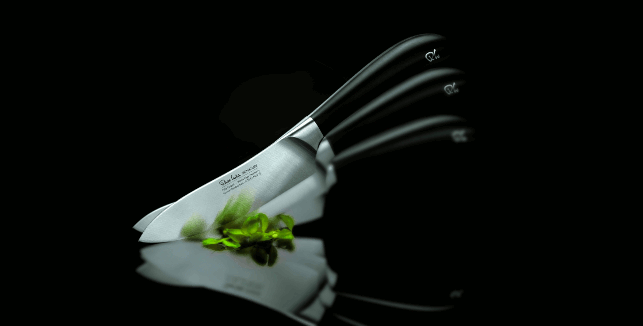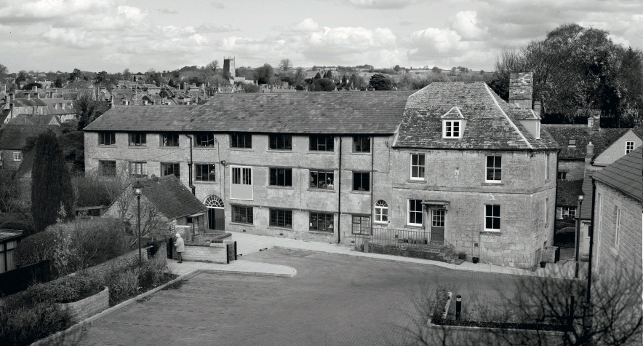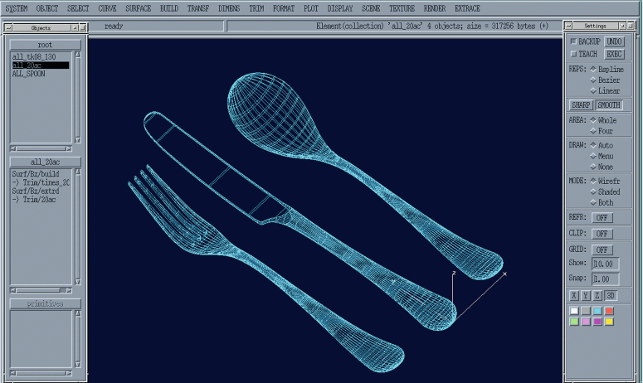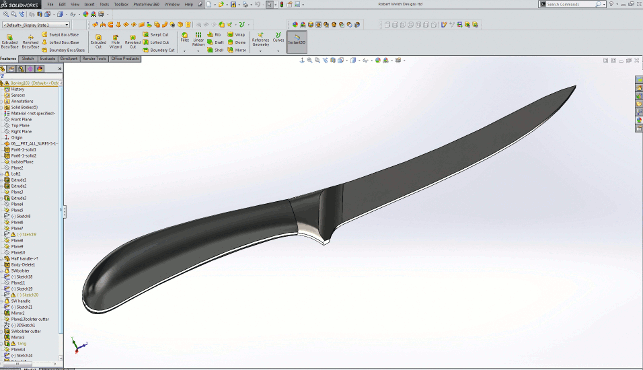Chopping food can be frustrating work if you don’t have a sharp knife. In my kitchen tomatoes mostly end up hacked and squashed rather than sliced clean through. So it was a revelation to use a Robert Welch Cooks Knife for the first time recently.

The Robert Welch cooks knife in the Signature range
It’s an absolute pleasure to chop with and incredibly sharp, evident by the nicks on my fingers, but also feels comfortable and satisfactorily weighty to hold. It definitely lives up to the philosophy of its namesake Robert Welch – value-formoney design that is innovative, aesthetically pleasing and functional.
Robert Welch (1929-2000), MBE and a Royal Designer for Industry, was an award winning industrial designer who specialised in stainless steel. He trained as a silversmith at Birmingham School of Art before heading to the Royal College of Art in London.
Following his graduation in 1955 he rented a small room in Chipping Campden’s Old Silk Mill that contained a bed and a drawing board. With the creation of the Alveston cutlery range Robert Welch Designs was born in 1961.
Over the next 40 years the company grew to take over the top floor of the Silk Mill producing a wide range of kitchen, dining and homeware products. In 1993 Robert Welch passed the directorship to his son and daughter, Rupert and Alice, who are still the managing director and marketing director respectively.

The Old Silk Mill in Chipping Campden
A Robert Welch retail shop was established in 1969, just a few hundred yards from the Old Silk Mill where the products are still designed by the in-house design team. In fact, during the past 50 years, over 3,418 individual new products have been designed, leading to sales of over 46 million around the world.
Design legacy
Walking round the Robert Welch shop, one of three with the other two located in Warwick and Bath, you realise just how vast the range really is.
Along the back wall is a museum dedicated to Robert Welch himself with a range of his original product designs on display. There are some beautifully retro pieces, including tea sets, clocks, candlesticks and even jewellery, some of which still look as contemporary today as they did originally.
“Many of his items are still in production today, it’s a testament to his legacy,” says Paul deBretton Gordon, head designer at Robert Welch Designs, on my guided tour of the shop.
deBretton Gordon is just one of three designers at the company. Although small, they make extensive use of technology in the design studio with two CAD packages, SolidWorks and Deskartes, and two 3D printers.

In 1955 Robert Welch set up his studio in one little room in the Silk Mill
The oldest is a ZCorp Z510, nicknamed Zelda, which has recently been superseded by an Objet 30 printer. “We bought Zelda eight or nine years ago so it’s pretty old technology now. We needed something more convenient with better quality. But with hundreds of different 3D printers out there we had to do quite a bit of research.
“It was really important that our new 3D printer wasn’t too big, the cost of running it was low and the quality of the model was high. A secondhand Objet machine came on the market and we thought it was too good a deal to turn down,” says deBretton Gordon.
Happily buzzing away in the corner of the design studio with no dust or smell, unlike Zelda, the Objet is used extensively for prototyping design concepts. “It doesn’t have a huge build area but for what we are using it for, it’s fitting the bill,” he adds.
Sophisticated design process
Although steeped in a tradition of craftsmanship and silversmithing, the design process at Robert Welch Designs is similar to most other companies involved in new product development.
This is something that amuses Paul deBretton Gordon and his wife Kit, who is senior designer at the company, as some people don’t think that cutlery is designed. “I remember having to explain to family and friends what we do as they think we are sat in something like an art class,“ she laughs.
When Robert Welch was the only designer at the company, before computers or CAD, his line drawings would be passed to a silversmith who’d bring his designs to life. In his case it was John Limbrey, a craftsman who joined Robert Welch in his one room studio shortly after he set up. He then worked with Welch for over 40 years producing models and production drawings.

Deskartes is an ideal tool for designing cutlery
Today a project will similarly begin with sketching but will very quickly progress into CAD. “We get into CAD as soon as we can because obviously CAD is a great time saver. That way we can start knocking out 3D prints and prototypes fairly early on,” explains deBretton Gordon.
“We try to get through the concept phase and into development phase pretty quickly because the development cycle can take quite a while. We also try to speak to our factories sooner rather than later.” But take a spoon, which is just one form, how complex can it be to design? Very, it seems.
“Talking about it sounds ridiculous, it’s just a spoon but the design is really tricky,” says deBretton Gordon. “The top surface is the most difficult and the challenge is for the three or four surfaces on that top surface to knit together into a solid.”
However, cutlery design always starts in the Deskartes software package as opposed to SolidWorks. Produced by a Finnish company of the same name, Deskartes is a Computer Aided Industrial Design (CAID) system with certain features that make it an ideal tool for designing cutlery. Although Robert Welch Designs’ license has been in use for almost nine years and can only operate on an old laptop, deBretton Gordon explains that this basic package allows for quick model creation and easy editing.

Seats of SolidWorks have since been purchased through reseller NT CADCAM
Once the Deskartes model is complete, it then writes an IGES file format that can be brought into SolidWorks. From there files are sent to the 3D printer, prototyping bureau or model maker. Following tweaks and refinement to the design, files then go to the factory for tooling.
Bright finish
One of the key challenges in working in this industry, which is really out of the designers’ hands, is the bright finish achieved through polishing the stainless steel.
“Polishing is a real skill and polishers are the best paid in the factory. It’s actually quite a dangerous process because it involves a spinning wheel at really high speed in very hot conditions,” comments deBretton Gordon.
Apart from polished stainless steel, the only other colour in the Robert Welch collection, excluding the children’s range, is black. This has always been the case and gives the range its timeless and modern aesthetic. deBretton Gordon was one of the first designers to take over the in-house design following Robert Welch’s death and was conscious of not taking the company in a different direction.

Robert Welch at work
“I wanted to continue in Robert Welch’s legacy and keep the design classic and simple. I have tried to accomplish that – the designs are not overly designed, they are not fussy, fashion driven or trendy.”
One of the first projects deBretton Gordon embarked on when he started, which has remained a favourite, is the multi-award winning Signature Knife range. “There have been equally good projects since but that one sticks in my mind as being enjoyable but also diffi cult as the learning curve was so steep,” he says.
“The company did have a few knife ranges but obviously those were designed by Robert Welch himself so this was a journey that Rupert Welch and I really went on together.”
It was also the project where deBretton Gordon introduced CAD into the company in the form of Deskartes having used it at his previous job at Wedgwood. They also purchased Zelda, which was used extensively on this project to prototype handles.
“At our design meetings we would have 20 different handle shapes testing the feel and comfort. In the early days, we also trialled a lot with professional chefs to make sure they didn’t get fatigue and the handle was right.”
The handle, which is made from a DuPont material, is moulded precisely onto the full tang. In other words, the knife is forged from one piece of stainless steel that extends the full length inside the handle ensuring longevity and durability.

The Signature range of stainless steel utensils with its bright finish
Not only was the design of each blade a challenge but so was the choice of steel. Instead of opting for a Japanese steel, which can be very hard but difficult to sharpen, they went for a German stainless steel, which is less hard but easier for users to maintain the edge and sharpen.
The knives were tested extensively until the perfect knife had been reached, which has since been awarded the highest grade possible by the Craft Guild of Chefs and won multiple design awards.
New products
The Robert Welch range is extensive and although products remain in the catalogue for many years, including some legacy ones that were designed by Robert Welch himself, new products are also added regularly.
Currently, the kitchen product range is being boosted with new utensils; the Signature Kitchen Roll Holder, with a design that allows for pull and tear in one movement, as well as a Signature Oval Trivet with a stainless steel base and removable silicone mat on top.
Although the design work keeps him busy, deBretton Gordon also likes to keep on top of new technology that could help the design process. “DEVELOP3D Live in April was great fun for that as all the relevant companies were in one place and you could literally walk from one space to another and try them out and see the results.

One of the recently launched products is this Signature Oval Trivet
I had a look at 3D scanners, which may be useful in future. And although we are happy with our Objet machine, there were some others there that were interesting and in the future we may get another and run them concurrently.”
Of course, all of this research and future technology investment is to ensure that this small company continues in its pursuit of excellence. I can’t help thinking that Robert Welch would be proud of how his company has progressed whilst it still maintains his belief that everyone should be able to use beautifully designed pieces in everyday life.
From 19 July to 28 September 2014 the ‘Robert Welch: Inspiration and Innovation’ exhibition will be taking place at the Court Barn Museum in Chipping Campden. On 19 July there will be a one-on-one event — ‘Designing for Robert Welch’ — with Alice Welch, managing director, and Kit deBretton Gordon, senior designer.
The lasting legacy of Robert Welch’s cutlery and kitchenware designs
Default






